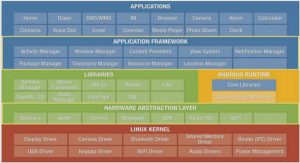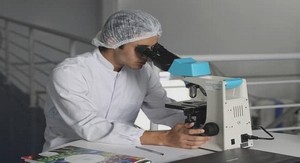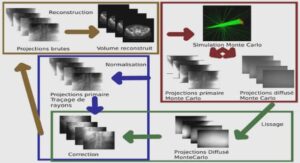Reproduction of PMHS tests with the THUMS model
Presentation of the THUMS model
The THUMS model is a full body human finite element model developed under LS-DYNA by Toyota Motor Corporation and Toyota Central R & D Labs., Inc.. The last commercial version of the model is version 4.0 as described in Shigeta et al. 2009. This model have proportions close to an average adult male (size 179 cm, weight 74 kg according to THUMS Manual (Toyota Motor Corporation 2011). The thorax and abdomen of the version 4.0 model have been created using CT 1 scans from a 39 year-old subject (size 173 cm, weight 77 kg). The scans were from the University of Michigan database. The model is available in two different positions. The model in the pedestrian (standing) position was directly build from the scans. The model in car occupant position was derived from the pedestrian model. Figure 4.1 shows the two commercial models. Models specifically positioned to reproduce PMHS tests from the literature received from Toyota Motor Corporation have been used for impactor and seatbelt simulations. The model has approximately 1300 parts, 1 800 000 elements and 630 000 nodes. Table 4.1 shows the different anatomical regions of the model along with the number of parts of those regions. The abdomen of the model can be seen on Figures 4.2a and 4.2b. The properties of the main parts such as type and number of elements, density and material law are detailed in Table 4.2. Each volumetric part is coated by a shell part for contact purposes or to represent the capsule of the organs if they have one. The hollow organs are modelled as compressible with a simplified hyperelastic material model (mat_057: low_density_foam) whereas the solid organs are modelled as incompressible with a hyperelastic rubber material model (mat_181: simplified_rubber), according to Shigeta et al. 2009. Those material models are detailed in Appendix C. The mechanical response of those models is based on an engineering stress / strain curve from uniaxial test data. The curves can be seen on Figures 4.2c and 4.2d. The liver data was obtained from Tamura et al. 2002 and the small and large intestine data was obtained from Yamada 1970. Three main contacts are defined in the model. All the parts in the contact are checked for penetration with all the others. The skin contact (Figure 4.3a) contains 34 parts and represents the outer surface of the body. It prevents the regions of the model of penetrating the others. The body contact (Figure 4.3b) is made of 201 parts and manly includes bones connecting tissues. The organs contact (Figures 4.3c and 4.3d), made of 18 parts includes the shell parts covering the organs and shell parts surrounding the organs such as the pleura or the peritoneum parts. Contacts create a non-penetration condition between the parts they include. The other way to create non-penetration condition between parts used in the model is to have the parts sharing the same nodes at their interface. This technique is used to link together the different part sets mentioned above in the different contacts.The simulations performed with the THUMS model were run using a fixed timestep of 4 × 10−4 ms achieved with mass scaling (as advised by Toyota Motor Corporation) and no gravity was applied.
Impactor simulations Impactor tests from the literature were selected to be reproduced in simulation
Only results from Hardy et al. 2001 mid-abdomen 6 m s−1 will be presented here. Other configurations (Cavanaugh et al. 1986 and Hardy et al. 2001 upper abdomen) will not be presented. The model used was a model positioned for impactor test configuration by Toyota Motor Corporation, as used in Shigeta et al. 2009. The mass of the impactor was adjusted to 48 kg and its velocity was set to 6 m s−1 . The differences between the model and tests from Hardy et al. 2001 are the position of the legs, which are not straight and supported by the floor surface. The position of the arms is also different since in the model they are not hung to a hook above the subject. It has been chosen to keep the model that way, as no major influence on the response was forecasted. To reproduce the mid-abdomen loading case from Hardy et al. 2001, the position of the impactor aligned with the L3 vertebra. The penetration was measured as the difference between y-coordinate of a node in the median plane of the impactor and a node on the back of the subject in line with the impactor node as seen on Figure 4.4b. The force is taken as the the y component of the contact force between the impactor as master part and the abdomen. Figure 4.5c shows the simulation response in terms of force and penetration although slightly less penetration is predicted by the model. The response is in good agreement with the PMHS data from Hardy et al. 2001. However the response matchs better the test data when considering abdominal compression instead of penetration as shown on Figure 4.5d. The compression is the penetration of the impactor into the abdomen divided by the initial abdominal depth of the subject. This is to take into account the disparity between the abdominal depth of the THUMS model and those of the test subjects from Hardy et al. 2001 as shown on Table 4.3. The abdominal depth of the model is the difference between the y axis coordinates of the nodes shown on Figure 4.4b in the initial state of the simulation. Figure 4.6 shows the deformed shape of the model
Seatbelt simulations
Seatbelt tests from Foster et al. 2006 and Lamielle et al. 2008 were reproduced in simulation. Toyota Motor Corporation provided the model used in Shigeta et al. 2009. Due to chapter length considerations, only the two conditions from Lamielle et al. 2008 will be presented here.
Lamielle et al. 2008 MHA condition
For Lamielle et al. 2008 MHA tests the belt was pulled by an hydraulic jack with the objective of reaching a constant speed. Two target retraction velocities of 4 m s−1 (MHA111 and MHA151) and 5 m s−1 (MHA115 and MHA155) were used. Figure 4.7 shows the belt retraction, velocity and displacement profile of the MHA tests. Table 4.4 shows the characteristics of the PMHS subjects. In order to reproduce the PMHS test condition, it has been chosen to impose the belt retraction profile over time. All tests from the MHA condition were simulated and the THUMS model showed a lower force level than the PMHS data. Therefore, the test with the highest retraction velocity of all, MHA115, will be used as reference since it gave the highest force level of all the simulated cases. Figure 4.8 shows the response of the model along with the PMHS curves. Penetration is in good agreement with the PMHS data, which is expected. The force magnitude is lower than the test data but the shape exactly the same the test responses. Figure 4.8d compares the force between the back of the subject and the test bench, for the test data as well as for the simulation. The back force predicted by the simulation is lower than the test data, in the same proportions as the abdomen force. An other difference is that the simulated back force is phase-shifted compared to the test data. That is the back force from the simulation starts rising approximately 15 ms after the force from PMHS tests. This could be explained by how the ubject is positionned against the seatback in both cases. In the simulation, the model has been translated until its back became tangent to the seatback plane. The coupling between the subject and the seatback is therefore weak before the simulation starts. It is likely that in the PMHS set-up, the subject back is already deformed against the seatback before the test starts, therefore creating a stronger coupling. Figure 4.9 compares the deformed shape of the simulation and images from the relevant PMHS test. In the PMHS test, the belt penetrates into the abdomen of the subject before the test starts. This initial penetration is due to the pre-tension of 20 N applied to the belt (10 N in each strand as mentioned in Lamielle et al. 2008). This applies to the PRT condition too where the initial penetration seems more important (see Figure 4.14d). Figure 4.10 shows the deformation of the seatbelt during the simulation and Figure 4.11a superimposes the belt deformed shapes along the simulation with the umbilicus point as fixed reference point. According to Figure 4.11b, the peak of belt penetration into the abdomen is the same as the peak seatbelt retraction.
Lamielle et al. 2008 PRT condition
It has been chosen to impose the belt retraction profile over time from test data in order to simulate PMHS tests. All tests from the PRT condition were simulated. The THUMS model showed a lower penetration level than the PMHS data. Therefore, the test with the highest penetration of all, PRT052, will be presented here and used in this chapter since it results is the closest to PMHS data. Figure 4.12 shows the retraction conditions for the PRT tests and Table 4.4 shows the characteristics of the PMHS subjects.As it can be seen on Figure 4.13a, the penetration response of the model goes lower than the test data after the initial loading phase. The peak belt retraction imposed in the simulation is 60 mm but the simulation gives a maximum abdomen penetration of 56 mm where 68 mm were expected. The interaction force between the belt and the abdomen (Figure 4.13b) has a magnitude comparable to test data but the profile over time of the force signal does not match the test data. The force in the simulation drops approximately 8 ms earlier compared to the PMHS results. Regarding the back force comparison, the force magnitude in the simulation is much lower than in the test. A phase shift is observed in the back force, it can be explained the same way as for the MHA condition. Figure 4.14 compares the deformed shape of the simulation and images from the relevant PMHS test. The fact that the model shows less penetration of the belt into the abdomen can be seen on the different pictures. It has been mentioned in Lamielle 2008 that for PRT tests (unlike the MHA tests), the belt retraction profile was different than the displacement of the umbilicus point of the abdomen. The umbilicus displacement was, after the initial period of the loading, higher than the belt retraction. This was believed to be the result of the lateral deformation of the abdomen causing more penetration of the belt into the abdomen compared to the belt retraction (the abdomen being incompressible). This also highlights the effect of the abdomen mass at higher velocities. However, this is not the case in our simulations. Figure 4.16b shows higher belt retraction than penetration all along the simulation, which could suggest that the mass effects that are observed in the PMHS data are not reproduced in the simulation. The incompressibility of the abdomen creates only very little lateral seatbelt deformation in the simulation (see Figures 4.15 and 4.16a).


